Man, what an awesome time to be involved with benchrest shooting. With the NBRSA making barrel tuners legal for Centerfire Benchrest, man, it’s going to be fun to watch what scores and aggregates are produced, just like it has been fun to watch the Rimfire Benchrest scores skyrocket since I introduced barrel tuners in the early 90’s..
I just published here in PS an article about Centerfire Benchrest tuners, but folks want to know why they work like they do to improve accuracy. I am going to attempt to explain just how a rifle barrel vibrates when fired and just why a barrel tuner causes increased accuracy. Man, I hope my crummy writing ability don’t get in the way of you folks understanding what I am going to say.
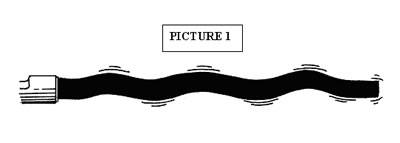
Rifle barrels do not vibrate with multiple oscillations like I show in this picture.
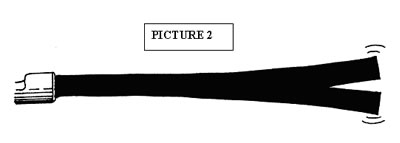
Rifle barrels do not vibrate with multiple oscillations like I show in this picture.
|
Folks, as I sit at this keyboard, it is the first of December, 2004. This is the 10 th anniversary of the article I published here in PS in December 1994, where I introduced barrel tuners to the world. In that article I described how a rifle barrel vibrates when fired. With this article I am going to refine what I wrote of back then. Nothing has changed since that article 10 years ago about my description of rifle barrel vibrations. But the shooting world has most certainly changed because of barrel tuners and now 10 years later Centerfire folks are getting ready to experience the awesome benefits of barrel tuners.
HOW DOES A RIFLE BARREL VIBRATE WHEN FIRED?
Folks, I bet there are very few folks on the face of the earth that have wasted as much time as me on rifle barrel vibrations over the past 15 years. I have written here in PS a couple of years ago about how I discovered the first barrel tuners and all the headaches I went through before I come up with something that actually worked. But I did not give much detail as to how a rifle barrel vibrates in that article. I’m going to try to do that now.
FIRST, HOW RIFLE BARRELS “DON’T” VIBRATE WHEN FIRED
I have done several rough drawings to demonstrate how rifle barrels vibrate when fired, and also how they don’t. Ok, please look at PICTURE 1, which is near.
In this first drawing, I show you how a rifle barrel does NOT vibrate when fired. All my life until I finally figured out how barrels do vibrate, I kinda thought a rifle barrel vibrated like this first picture. I thought there were multiple cycles and nodes in the vibration pattern but there is not. And I believe I was not alone in my thinking. I think a lot of folks believe this is how a barrel vibrates, even to this day.
Ok, if you will please look at PICTURE 2, which is also near. This is another rough drawing showing how a rifle barrel does NOT vibrate. I believe some folks believe this is the way a barrel vibrates, even today. Now, if a rifle barreled action was clamped in a vice by the action, and if you were strong enough to grab the muzzle and bend the barrel over to about a 30 degree angle and release it, it would vibrate back and forth like PICTURE #2. But the emphasis that causes a rifle barrel to vibrate, the firing of a cartridge in the chamber, starts from the breech end of the barrel, not the muzzle. No, rifle barrels do NOT vibrate like PICTURE 2.
NOW, HOW RIFLE BARRELS “DO” VIBRATE WHEN FIRED
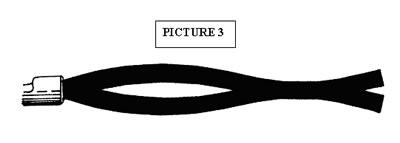
This is the way a rifle barrel vibrates when fired.
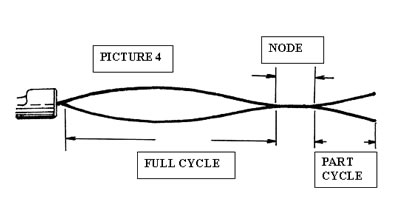
This is a line drawing showing the three components of a rifle barrel’s vibrations when fired. There initially is a full cycle, which blends into the parallel node, or dead spot, which blends into the part cycle at the crown. This part cycle is what kills accuracy.
|
Please look at PICTURE 3, which is near. Folks, this is how a rifle barrel vibrates when fired. This rough drawing depicts a fairly heavy barrel. Folks, I have exaggerated these drawings to emphasize my points.
OK. Now please look at PICTURE #4, which is also near. I have made a simple line drawing to show you in detail what the vibration pattern of a rifle barrel looks like and to allow me to dissect it better. Ok, here is what we have. Starting at the receiver face we have one long cycle, which blends into the node, or dead spot, then the node, or dead spot, blends into a partial cycle ending at the crown of the barrel. This partial cycle at the muzzle is what causes a rifle barrel to be inaccurate. And a very important point now. The stiffer the barrel is, the closer to the muzzle the node, or dead spot, is located. If the barrel is fired and the partial cycle is in its upward position, the shot will print high on the target. If the next shot exits the muzzle with the partial cycle in its downward position, the shot will go low of course. The goal of hand loading is to hopefully cause the bullet to vibrate the barrel exactly the same every shot, hoping to cause the partial cycle to be at the exact same location every time a bullet exits the muzzle.
The really accurate grouping from a target barrel comes when the hand load is such that it causes the partial cycle to be either at its highest or lowest point, because the muzzle of the barrel comes to rest for a millisecond at these two extremes. When you have a load developed for your benchrest rifle that has eliminated 100 percent of the vertical dispersion, the partial cycle of your barrel’s vibration pattern is either at its highest or lowest extreme.
And something else. A rifle barrel is usually discharged in a horizontal position, particularly a benchrest rifle. This means that the forces of gravity influence the vibrations of the barrel. This means the bulk of the vibrations of a rifle barrel, when fired, are in a vertical plane.
Folks, before I go further, I would like to say something. The vibration pattern of a rifle barrel, when fired, is exactly like I show in PICTURE 4. It is against the laws of physics for it to be otherwise. Once every 24 hours the earth we live on rotates in such a way that the sun causes light for a new day for us. This fact can’t be changed. No matter how much one wished the sun would not come up, it’s going to. If you take a 10-pound lead ball and drop it, it’s going to fall straight down. It will not fall upward or fall away from you. It will fall straight down. The laws of gravity will not allow it to do otherwise. No matter how much one would wish for the 10-pound lead ball to fall upward, it can’t, and if your toe is in the way, well it’s going to hurt. Folks, the vibration pattern of the free end of a rifle barrel that I have described above, is controlled by the same laws of physics that control the rotation of the earth and the forces of gravity. It is impossible for the free end of a rifle barrel, when fired, to produce any vibration pattern but the one I have just described.
Now Bill, man, that’s a pretty strong statement. Yes it is, but after 15 years of fooling with barrel vibrations, which included every experiment I could possible devise, I still can’t cause the free end of a rifle barrel to vibrate, when fired, in any other pattern. It simply can’t be done.
Folks, when one gains an understanding of how a rifle barrel vibrates when fired, then a bunch of other questions that we have always wondered about all of a sudden get answered. I’m going to give a good example later on in this article.
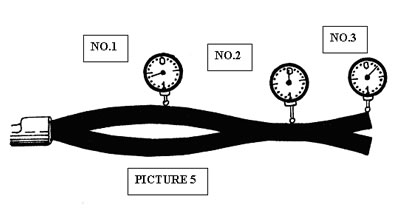
I try to show in this picture the degree of vibrations at the three component parts of a rifle barrel’s vibrations by using dial indicators. One complete revolution of the sweep hand is meant to represent .002” movement. Indicator NO.1 reads .0014”, NO.2 reads .000” and NO.3 reads .00025”.
|
Folks, I’m sitting here at this keyboard trying to figure which way I want to go from here. Man, I have got to do this so you folks can understand it. At the moment I am at the point in my writing career where I wish I knew some bigger words.
OK, I’ve decided to do another rough drawing of the proper vibration pattern of a rifle barrel when fired. Now folks, this is really important. I am going to show some dial indicators that I have placed on the barrel in three locations. Now, let me explain something about these three dial indicators please. I want you folks to visualize one complete revolution of the pointer as measuring .002” or two thousandths of an inch. I’m doing this for illustration purposes because the barrel vibrations are so small that if I tried to show them on a regular dial indicator, you could not see the difference in the position of the pointer. I hope I have made sense here folks.
Now, near is PICTURE 5. The barrel I am representing here is a heavy barrel similar to the ones found on Centerfire Benchrest rifles. Dial indicator No. 1 that I show positioned in the middle of the complete vibration cycle, while at the height of the vibration cycle, as the barrel is being fired, reads .0014”, or one and four ten thousandths of an inch. Dial indicator No. 2 that I show positioned on the “node”, or dead spot, reads ZERO. Dial indicator No. 3 that I show positioned at the partial cycle at the muzzle, while the partial cycle is at its extreme position, reads .00025” or two and one half ten thousandths of an inch. Now folks, these are very small figures but if you think about it, with the partial cycle at the muzzle vibrating a total of .0005”, or a half thousandth of an inch, if two bullets exit the muzzle, one at the uppermost extreme of the partial cycle, and one at the lowermost extreme of the partial cycle, by the time those two bullets reach a target 100 or 200 yards away, they are going to be an inch or two apart. A little later I am going to show this same barrel, but with a barrel tuner attached to the muzzle, with these same three indicators placed on the barrel to show you why a barrel tuner works.
Bill, I’ve read what you’ve said up to this point but man, how do I know what you’ve told me so far is correct? Man, that’s a good question. Ok, think about this please. A rifle barrel is a steel rod. There is a simple test that anyone can perform that will demonstrate how a steel rod, attached to something stable at one end, and made to vibrate, looks. If you take a piece of 3/32” diameter welding rod, three feet long or so, clamp one end in a bench vice, and cause it to vibrate, you will see the pattern that I describe above. If you pull the end of the rod to one side, then let go of it, it will swing back and forth. But like I said earlier, a rifle barrel is caused to vibrate with emphasis induced from the breech end, not the muzzle. If you hold the tip of your welding rod, while the other end is clamped in a vice, and twang it like a guitar string, you will see the same vibration pattern that happens when a rifle barrel is fired.
Folks, there is no other vibration pattern that a rifle barrel makes when fired. Again, the laws of physics will not allow it.
Folks, in an earlier article here in PS, I describe how I accidentally discovered the different sound that a barrel makes, when hung up by a string, and struck with a little brass hammer. If you “ring” a barrel with a hammer, suspended from a string, the chime sound will be exactly the same, no matter where you strike the barrel, EXCEPT, when you strike the node or dead spot, which will be located near each end of the barrel.
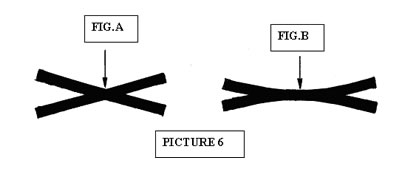
These two figures in picture 6 show the incorrect shape, FIG. A, of the node, or dead spot, in the vibration pattern of a rifle barrel when fired. FIG. B is meant to show the correct shape of the node, or dead spot, in the vibration pattern of a rifle barrel when fired.
|
If you run the little experiment with the welding rod clamped to a bench vice, once you get it vibrating, you will be able to take your thumb and first finger and grab hold of the node or dead spot and the barrel will continue to vibrate. But if you touch the vibrating welding rod at any other place, the vibration stops, immediately. See folks, this thin welding rod is just like a rifle barrel. It will show you the exact same vibration pattern that a rifle barrel exhibits when fired.
But Bill, man, you ain’t no scientist. What if I tell you that I still ain’t convinced that what you are saying about how a rifle barrel vibrates when fired, is correct. Ok, let me answer you this way please. There are some folks who will never be convinced, but when I get into the part of this article about how a tuner works, there will be no question that a rifle barrel vibrates exactly like I have described in my little rough drawings.
See folks, a sailor can’t see the wind, but he knows if he hoists his sails, he can see the RESULTS of the wind when the sails billow out and the ship moves forward. An astronomer can’t see the planets of a distant galaxy, but he can see the RESULTS of the gravitational force that stars exert on planets as they pass close to them, allowing the astronomer to know they are there. See, if a barrel did not vibrate exactly like I have described, a barrel tuner could not possibly work, but they of course do. I know exactly how the free end of a rifle barrel vibrates, when fired, not only by the experiment with the welding rod but also by the RESULTS I see when a barrel tuner increases accuracy.
NOW, HOW DO BARREL TUNERS WORK? Folks, here is a real short answer then I will go into the details. A barrel tuner causes the muzzle to be free of any vibrations when the bullet exits it. So how does it accomplish this miracle? A barrel tuner kinda fools the barrel into moving the node, or dead spot in the vibration pattern that is located just back of the crown, to the exact muzzle (crown). This allows the bullet to exit the crown with the crown in a stationary position.
Ok, there is an argument that has been bandied about by some folks, that if you do move the “node” or dead spot to the exact muzzle, the angle of approach from the major cycle will still cause the bullet to exit high one time and low then next. If you will look now at PICTURE 6 please, which is near. In PICTURE 6 I show two figures. Please look at the figure on the left, FIG A. I try to show the node, or dead spot, in the vibration pattern of a rifle barrel when fired as and X pattern. If this is how the node was actually shaped and if the center of the X was at the exact crown, then of course the angle of approach to the crown would cause high and low shots and those folks would be correct.
But folks, the node, or dead spot, in the vibration pattern of a rifle barrel when fired, is actually shaped like FIG B, in PICTURE 6. The node actually runs parallel to the axis of the bore. It is NOT shaped like an X. So when the barrel tuner caused the node, or dead spot, to be at the exact exit of the crown, the angle of approach to the node does not cause high or low shots, because the bullet leaves the muzzle parallel to the axis of the bore, every shot, no matter what position the major vibration cycle is in. Man, folks, have I made any sense at all here?
Ok Bill, man, how do you know the node, or dead spot, is shaped like a little parallel section of the barrel, and not like an X shape? That’s a good question. I’ll answer it this way. First, if the node, or dead spot, were in the form of an X, a barrel tuner could not possibly benefit accuracy. But barrel tuners DO benefit accuracy. Second, remember when I told you earlier about being able to hold my thumb and first finger on the node, or dead spot, of the 3/32” diameter welding rod as it vibrated, and the vibration would continued, but if I touched the welding rod at any other location, the vibrations would stop? Ok, think about this for a moment please. If the node, or dead spot, of a length of 3/32” diameter welding rod did form an X pattern, how could I hold the node with my thumb and first finger, which cover an area of at least one half inch long, without stopping the vibration of the welding rod. Folks, did I put this so it makes any sense at all? The only way I could grab the node, or dead spot, with my finger and thumb and not stop the vibrations is if the node, or dead spot, runs parallel for a short distance, which it does. It simply does not form an X shape.
So when a rifle barrel vibrates, the node, or dead spot, consists of a little section of the barrel that is perfectly parallel. A barrel tuner causes this little parallel barrel section to be moved to the exact crown of the barrel. So the fact that the barrel, right behind the node, or dead spot, is vibrating, the angle of approach to the node has no effect on accuracy. The bullet is always exiting that little parallel section of the barrel, which is perfectly stationary, which is caused to be at the exact crown of the barrel by the actions of the barrel tuner. It’s awesome!
But Bill, are you trying to tell us that a bullet can approach the parallel node, or dead spot as you call it, at an angle caused by the full cycle, then be straightened up enough in that little short parallel node to cause an increase in accuracy? Absolutely I am! Man, in a target quality, properly constructed barrel, the last orientation of the bullet as it leaves the crown is what causes accuracy. A couple of years ago PS published a couple of letters between a barrel maker in New Zealand and me. In my letter I talked about my “nut barrel” experiment. I took a match quality, lapped, rimfire barrel, fit it to one of my XP-100 conversions, cut the barrel so it only had about ¾” of rifling, crowned it and machined a hex nut shape to the end of it so I could get a crescent on it to tighten it in the receiver. When you looked at the gun from the side it looked like it had no barrel at all. I had to tape the bottom of the 24-power scope to protect it from the muzzle blast and man, that little thing popped when fired. Using good match grade ammo, I shot some sub 1” groups with it at 50 yards. And that was with just ¾” of rifling. Yes, the directional effect of the short parallel node, or dead spot, is plenty long enough to cause killer accuracy.
A thought. If the increased accuracy produced by a barrel tuner were only due to it being a weight attached to the muzzle, then why would it need to be adjustable? In other words, if all a weight attached to the muzzle did, was to slow down the rate of the muzzle oscillations, or decrease the severity of them, then the weight would not need to be adjustable. But the weight, in and of itself, is not what causes a barrel tuner to increase accuracy. No, it’s being able to adjust the weight of the tuner very accurately, so it will position the tuner weight at exactly the correct spot to fool the barrel into moving its node, or parallel dead spot, to the exact exit of the crown.
See folks, what the tuner does is to displace enough barrel weight in front of the muzzle so the parallel node, or dead spot, is at the exact exit of the crown and it must do this very precisely. THEN, the tuner itself takes the place of the partial cycle, then the tuner vibrates just like the partial cycle does on a barrel without a tuner, leaving the parallel node, or dead spot, to remain stationary so the bullets exit the same place every shot.
Folks, ain’t it simple when you think about it? Man, this stuff is so neat. Man, I hope I have written this good enough so it makes sense to you folks.
Now, earlier, I told you about some of the problems we have encountered in past that have new light cast upon them when one understands exactly how a barrel vibrates when fired.
Here are a couple of examples.
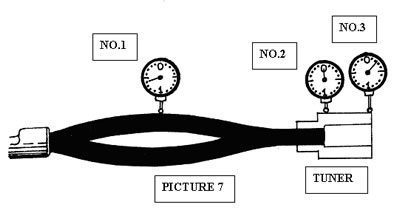
I try to show in this picture the degree of vibrations of the three component parts of a rifle barrel’s vibration pattern, WITH A TUNER INSTALLED. Indicator NO.1 reads .0014”, NO. 2 reads .000” and NO. 3 reads .00025”. If you will notice, the parallel node, or dead spot, is now at the crown and reads .000”. And now the tuner itself becomes the partial cycle and oscillates, just as the partial cycle did without the tuner on the barrel.
|
Why, with all things being equal does a stiff barrel out shoot a skinny one? If you will remember what I said earlier, the stiffer the barrel, the closer to the muzzle that the parallel node, or dead spot, is located. See folks, the closer the node is to the muzzle, the less severe are the oscillations of the partial cycle. So a stiff barrel, without a tuner, will be more accurate than a skinny barrel without a tuner because its parallel node, or dead spot, is closer to the muzzle, resulting in the partial cycle oscillations being less severe. By the same token, a skinny barrel, without a tuner has its parallel node, or dead spot, farther away from the crown resulting in more severe partial cycle oscillations and less accuracy. So benchrest and target shooters have gravitated to heavy barrels over the years.
Now, another example of being able to understand a problem by knowing exactly how a rifle barrel vibrates when fired. I need to tell you a story first.
Years ago I bought a new Remington Model 700 ADL in 222 Remington caliber. I wanted a ground hog gun. I also bought a couple of boxes of Remington factory loads. I put a K-10 Weaver on it and took it to the range. Some of my buddies were there and I sighted it in and shot some groups and it shot pretty good, wasn’t hot by no means. So Bill Calfee knew just how to help the accuracy of this little rifle. I took the thing home, got a wooden dowel rod, wrapped it with sand paper and sanded out the barrel channel in the stock and floated the barrel. Remington back then, and maybe now too, left a raised section in the barrel channel of the stock right at the fore-end tip to apply upward pressure to the barrel. They did this because over the years they discovered a little fore end pressure on those skinny, sporter weight barrels would make a greater percentage of them perform better than if they floated those light barrels. Anyway, I floated my barrel and headed back to the range. My buddies had gone which was a blessing, as that rifle would not shoot in a bucket with that barrel floated. I wound up gluing a yellow plastic shim back in the fore-end tip to put pressure back on the barrel and it went back to shooting ok. Back then I did not hand load and of course folks float sporter barrels and hand load for them and improve accuracy sometimes. I got rid of it because it was not too hot.
Now, why does putting fore-end pressure on a skinny, sporter weight barrel sometimes help improve accuracy? Remember what I said earlier, the stiffer the barrel, the closer to the crown is the parallel node, or dead spot. Which means the skinner the barrel the further away from the crown is the parallel node, or dead spot. And remember that I also said if you touch the barrel anywhere but the parallel node, or dead spot, while it was vibrating, the vibration stops. See folks, when Remington put that fore-end pressure on those skinny, sporter barrels, what they did in effect was to stiffen the barrel. The spot in the barrel channel that was exerting pressure on the barrel now became the face of the receiver, as far a barrel vibrations was concerned. So in effect, the barrel went from being 24 inches long to being 12 inches long, which made it stiffer, which pushed the parallel node, or dead spot, closer to the muzzle, which shortened the severity of the partial cycle oscillations, which caused more of their sporter barrels to be accurate than if they had floated them and remember this; Remington also sold factory ammo and they had to make thousands of Mod. 700 rifles in 222’s shoot good with their factory loads.
CONCLUSIONS
Folks, it has been fun writing this article. I am excited about Centerfire Benchrest allowing the use of barrel tuners. It has been fun witnessing the improvement in Rimfire Benchrest scores these last 10 years because of barrel tuners. The same thing is about to happen in Centerfire Benchrest shooting. Man, I’m ready.
Thanks to Dave Brennan and PS for allowing me the opportunity to write, and thanks to you folks for taking the time to read it.
Bill Calfee, Good Shooting
|